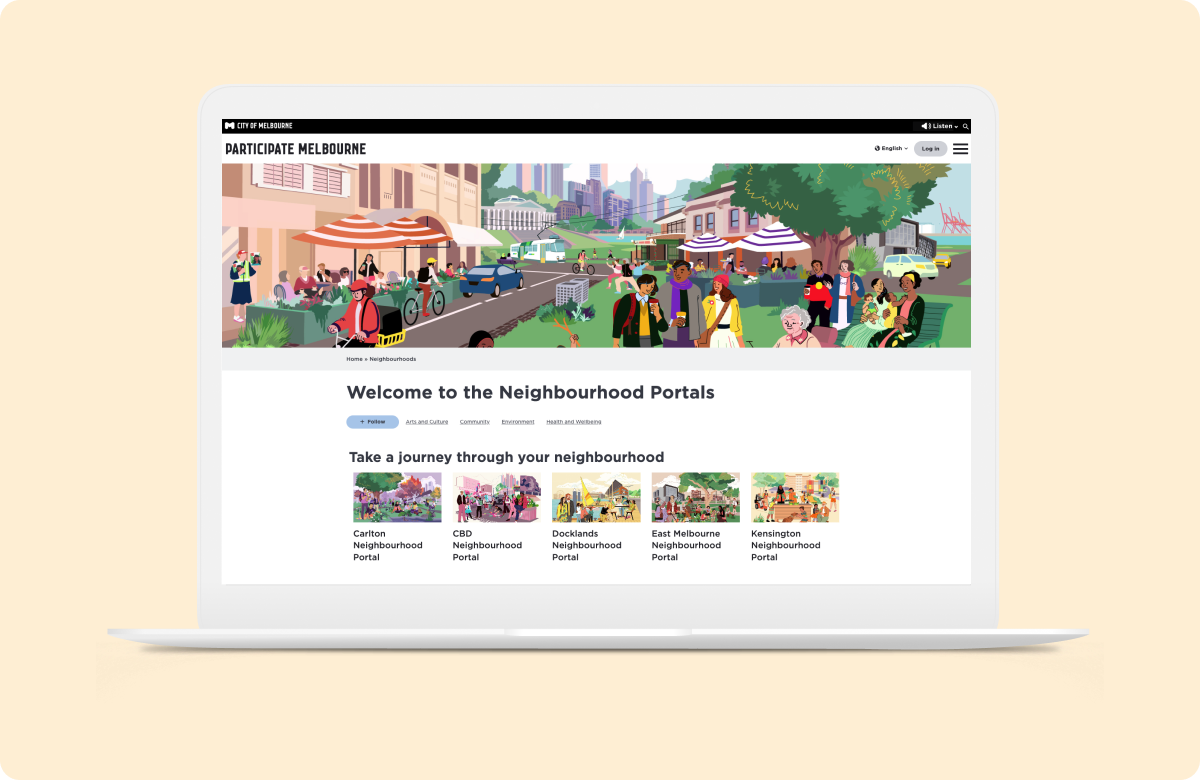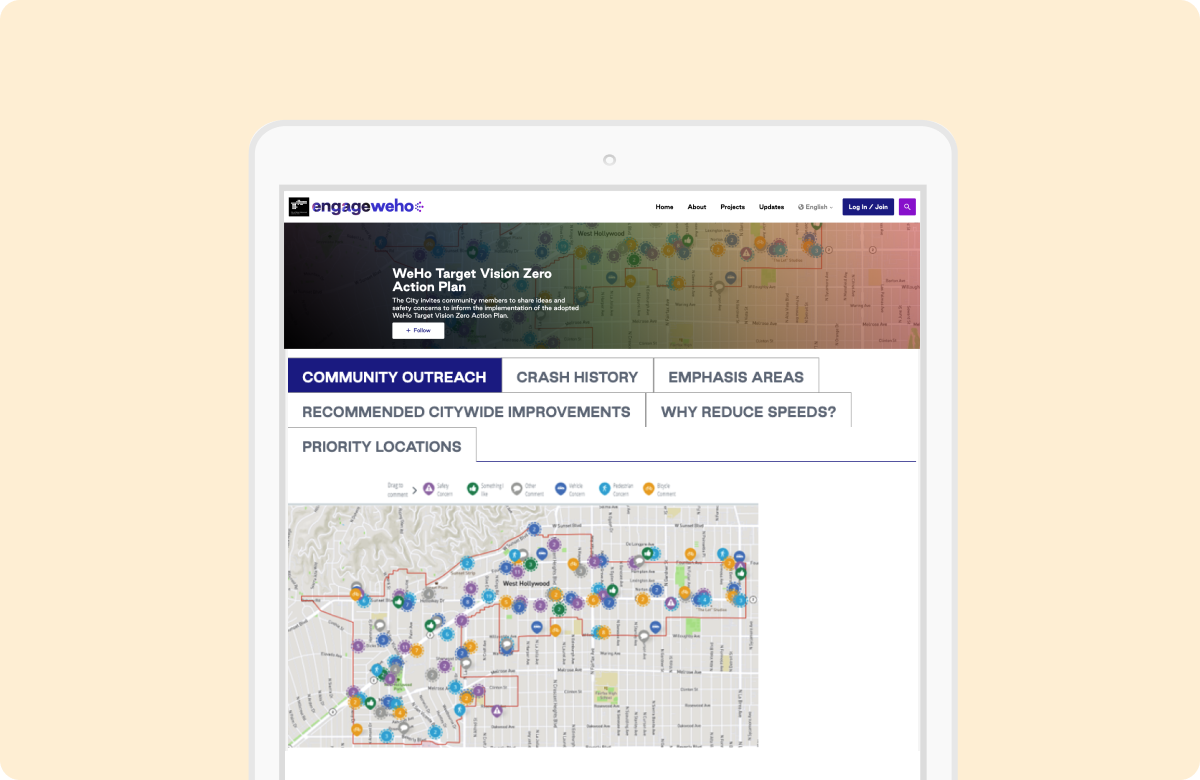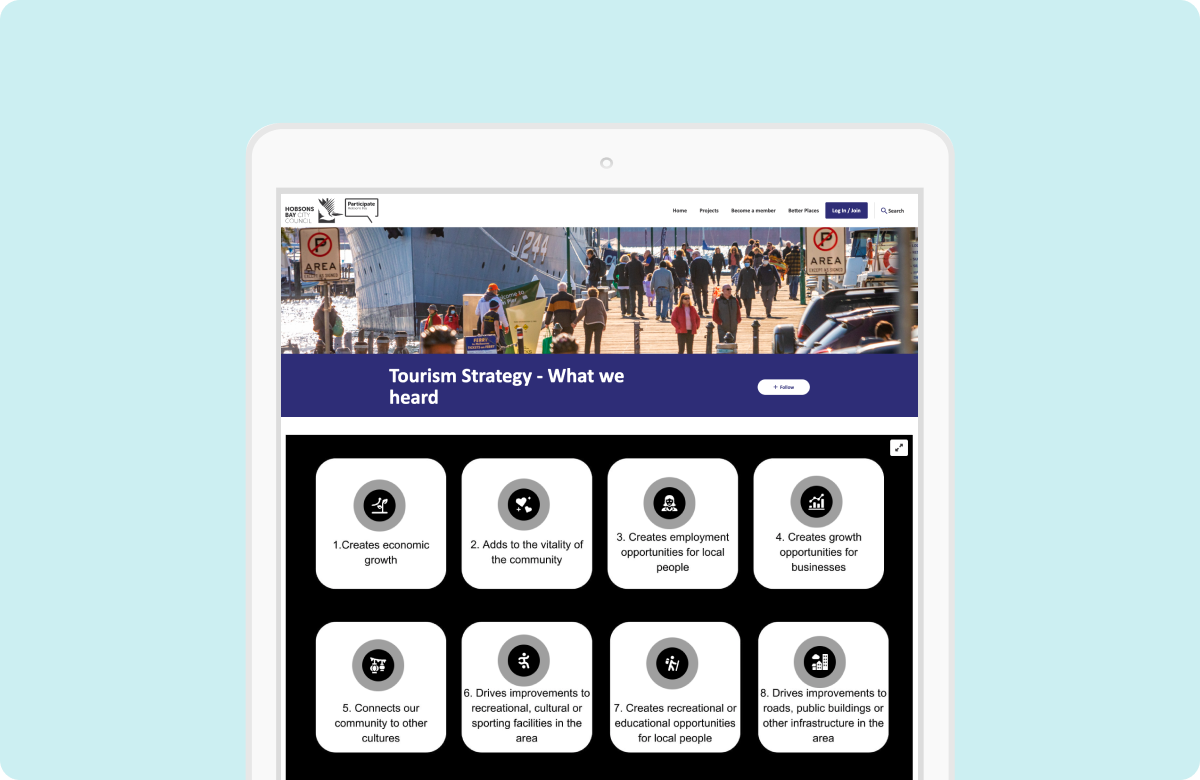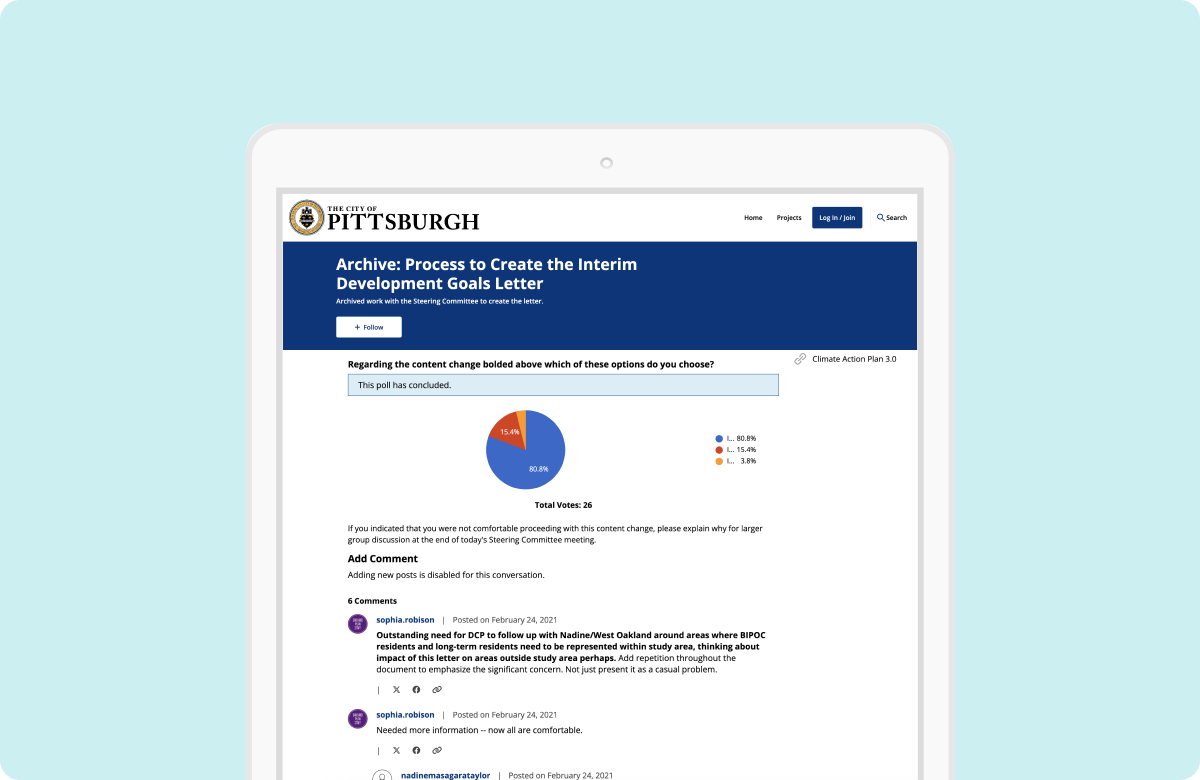We are in the enviable position of collaborating with hundreds of organizations worldwide and innovating together to drive community and stakeholder engagement forward. Our clients range from local and state governments to industry and nonprofits that use and rely on engagement in their decision-making processes. This experience allows us to take a pulse of engagement strategies and outcomes across a variety of fields and reflect on emerging online community engagement trends for 2024.
Here are our top 5 online community engagement predictions for 2024:
- Hyperlocal Engagement
- Elevated Data Transparency
- AI Adoption at the Organization Level
- Community Empowerment in (Private) Digital Workspaces
- Low Barrier Engagement
1. Hyperlocal Engagement
Communities are very familiar with public engagement, and since COVID, they have become increasingly hyperlocal in their thinking and acting.
In most cases, this would be defined along the lines of geography. For example, a street, a neighbourhood, and a suburb. But it could extend to digital groups such as defined groups, panels, and boards. Organizations will need to and are adapting to this shift with appropriate information and consultations targeted at specific communities on hyperlocal projects.
For example, most local governments across Australia run tree planting schemes on a street-by-street basis where old trees and non-native species are replaced – this is known as Street Tree Renewal projects. Usually, the engagement around this is specific to the residents of that street only where trees are being replaced. This process limits the local government to maybe a handful of streets a year if they follow a process of mail-drop, feedback, and tree planting one street at a time.
By using a digital engagement platform like Social Pinpoint, consultations like this can be run concurrently or consecutively at a very hyperlocal level to scale engagement. These spaces can be built out to discuss and help local governments manage the process in an agreeable timeline, collaboratively with their communities.

An example from Canada, the Resort Municipality of Whistler is hosting two tandem engagement projects – one more general and one hyperlocal. The more general project is collecting broad feedback on Municipal Facilities, while the more focused and hyperlocal engagement is collecting feedback from youth and parents surrounding a specific Youth Centre. By dividing these into separate consultations, they’ve been able to create engagement strategies that reflect the need to bring younger and more diverse voices into decision-making processes.

At the City of Melbourne, hyperlocal has been on the agenda for a while now. Their Neighbourhood Portals allow community members to find projects in their neighbourhood and provide feedback using a variety of tools, including adding comments on maps. The data collected is then fed into a knowledge database for the various City of Melbourne staff teams to access and benefit from in the long term. This helps to cut down on engagement fatigue and repetitive questioning. In some cases, we know it has also had a big impact on giving a participation boost to ‘less attractive’ projects by associating them with the ‘more attractive’ ones.

Likewise, the City of Melbourne’s Urban Forest project has focused on reviewing Urban Forest Precinct Plans as implementation guidelines that underpin their wider Urban Forest Strategy. The 10 very specific precinct levels are where people can provide hyperlocal feedback by commenting on a Social Map. The project started in 2023 and will continue at least until 2025.
2. Elevated Data Transparency
Similar to the above, we’ve seen a growing expectation from the public for transparency on how their input is being actioned. They’re asking for greater detail on how engagement data is analysed and used for smarter decision-making. They want to feel that their opinion is valued.
Today, organizations are receiving larger data sets, not just from traditional in-person activities, but also digitally from platforms like Social Pinpoint and social media. With that, managing data has become increasingly important and using the data appropriately even more so.
Many organizations use tools, like Consultation Manager, to track stakeholder interactions in one place, cross-reference data across projects and use data beyond a single project. At the project level, they use Social Pinpoint to further analyse sentiment using AI, create thematic word clouds and highlight comments using visualization tools like maps, charts and graphs. The recent integration between these two solutions is helping engagement professionals save time and take their analysis to the next level. Still, others are turning to dedicated BI tools using our open API.
In Australia, the Cities of Melbourne, Wyndham and Casey are just a handful of Social Pinpoint users now accessing high levels of data via our open API to feed into PowerBI tools to create amazing custom dashboards for internal use and charts, some even sharing live feedback with their communities. This use case is on the rise as organizations want to show how data is working for them and their community.

Having recently completed the public feedback portion of their Target Vision Zero Action Plan, the City of West Hollywood in California is now using its Social Pinpoint project page to close the loop and push the results and conclusions from that feedback back to the public. With an overview of the process, they use Social Pinpoint’s Tabs tool to break down their feedback into easily digestible sections. For example, under the Community Outreach tab, they use a screenshot of their final Social Map and under the Crash History tab, they review historical data.
While the plan has now been adopted by the City, they are still encouraging anyone who lives, works or spends time in West Hollywood to review the plan and provide feedback. This ongoing feedback will inform the next stage and the implementation of the proposed safety improvements recommended in the plan.

In 2024, we will certainly see more organizations transparently sharing engagement results online, like Hobsons Bay City Council. They close the loop on projects using a variety of content tools, like Facts and Hotspot in their Social Pinpoint toolkit, to share what they heard back to the community. They also use the data beyond the single project to promote smarter use across projects.
We are already seeing growth in data transparency and smart use this year, whether it’s sharing data internally for others to benefit from across departments (like the City of Melbourne’s, Neighbourhood Portals) or by including older yet still relevant data in project decision-making.
3. AI Adoption at the Organization Level
AI is here to stay and grow, hopefully with us. In 2023, early adoption was all about the ‘wow’ and exploring what AI could do for us as individuals. We saw no formal training, no rules and quickly developing products. Now, as we move into 2024, what we predict is that the ‘wow’ factor will fade and we’ll see serious adoption to enhance speed and efficiency at the organizational level.
Organizations have been working to explore the organizational risks and benefits of applications like ChatGPT and Dall-E, slowly trying out different systems and prompts to improve internal processes around survey writing and data analysis.
While data privacy and reputational risk remain major stumbling blocks to more mainstream application of AI in government, we anticipate that organizations will spend the next year developing robust internal systems and norms to establish acceptable use of these tools specific to the government context and even choosing preferred tools and creating “closed loop” AI systems.
The intersection of AI and community engagement offers a promising horizon. AI introduces efficiencies, personalisation and data-driven insights that can redefine the participation experience. Yet, balancing this technological prowess with the intrinsic human touch that has always underpinned interpersonal relationships is crucial. For more, see our blogs on ‘Will AI Replace Community Engagement’ and ‘10 Ways to Use Artificial Intelligence (AI) in Community Engagement’, including a downloadable prompt guide below.

For AI to be used responsibly and ethically in a way that fosters positive and inclusive community engagement, organizations will need to create systems that ensure data privacy, avoid biases in AI algorithms and maintain transparency. It will be interesting to examine the differences in how different parts of the world, with varying data protection laws, approach the normalization of AI tools – perhaps a topic for next year’s trends article.
4. Community Empowerment in (Private) Digital Engagement Workspaces
“Empower” has now been on the IAP2 Spectrum for 34 years and in 2024, we expect social empowerment in digital engagement workspaces will become more popular as a tool to aid deliberation, collective impact and ongoing relationship building. In particular, we predict growth in open dialogue models being applied both in private and semi-private workspaces to facilitate citizen panels, strategic planning and budgetary processes.
We’ve seen many Social Pinpoint users leverage private projects to create mini-collaboration and empowerment spaces that are specific to one issue or group. This can range from a birdwatching group to a greenway cleanup coalition, to a collection of nonprofits working in refugee resettlement.
Our Recovery is an example of a semi-private workspace hosted on Social Pinpoint – it combines public-facing transparency about members and the work of various groups. It facilitates private discussion spaces that empower those committees to work together during recovery after a natural disaster, using a place-based, community-led approach to ensure projects, grants and support programs developed are the right fit for the community.

5. Low Barrier Engagement
This is a trend that has slowly been gathering steam globally over the last few years and covers the ability to offer your community the opportunity to engage in a project with little barrier to participation but maximum impact. In digital engagement, this means creating a pathway for engagement that reduces clicks, offers rapid feedback opportunities and avoids text-heavy documents. The idea is that you can carve out a path to engagement that reaches those who have very little time or capacity and a parallel path for those who have more time or capacity – yet both sets of input are aggregated and equally valued in the final decision-making process.
At Social Pinpoint, we see an increasing number of organizations designing participation strategies in this way and we expect this to trend up in 2024. Organizations will, for example, offer different digital, hybrid and in-person engagement options and indicate how much time each will require.
We will see more project pages that say:
- “If you have 30-seconds, take this Quick Poll;
- If you have 5 minutes, leave an idea via the Visioner board;
- If you have 15 minutes (or more!), visit us in person at the pop-up at this place, on this date and at this time.”
There’s also an opportunity here to use various content tools to break down large text-based documents into bite-size relevant information to help people access the key elements of a project without the barrier of needing to download a heavy-weight document. A popular tool being used here is the Facts Card.
In 2024, we think we will see a big increase in the skill of producing low-barrier engagement. The ability to offer participants a choice of engagement opportunities based upon their self-determined interest and capacity is not an easy thing to do or manage, but an important part of bringing in more diverse voices. With the support of a high-level Customer Success Team, like the one at Social Pinpoint, we anticipate a move away from the question-heavy survey and associated survey fatigue and a shift towards more deliberative and interactive tools like Gather and Social Map.
What do you think? Were we right with our review of 2023 in part one, and do you think our predictions for 2024 will be correct?












